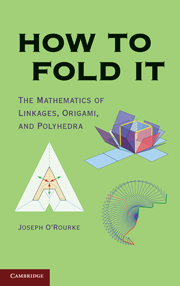6 - The Shopping Bag Theorem
Published online by Cambridge University Press: 05 June 2012
Summary
In Part I of this book, the linkages we studied all used rigid one-dimensional links. Although the flat origami foldings we've examined in the previous two chapters end up with flat “faces” between the creases, it is a rare origami folding that can reach its final folded state without bending the faces during the construction process. Origami designs that tuck flaps of paper into pockets, such as the map folding puzzle in Figure 4.14, clearly require face bending. Even forming the standard origami crane (Figure 4.1) is impossible if the paper is only bent along the final creases. As long as bendings do not become creasings, the properties of paper ensure that the faces of the design – the regions bounded (i.e., outlined) by the creases – can be smoothed flat in the final design.
The new field of rigid origami is focused on designs that can be folded without bending the faces. We can think of the faces as rigid steel plates, hinged along creases to the adjacent plates. Although rigidity limits the range of designs that can be folded, those that can fold often have useful applications.
We set as the goal of this chapter proving the surprising result that the standard grocery shopping bag (Figure 6.1) cannot fold flat without bending the flat portions of the bag. Of course collapsing a grocery bag requires bending at its creases, but it also requires bending its flat faces.
- Type
- Chapter
- Information
- How to Fold ItThe Mathematics of Linkages, Origami, and Polyhedra, pp. 84 - 98Publisher: Cambridge University PressPrint publication year: 2011



